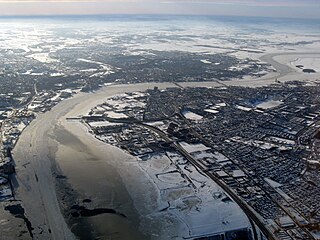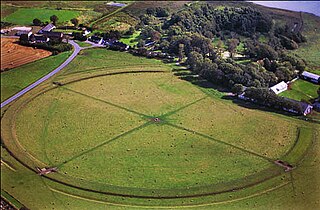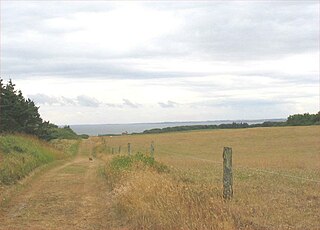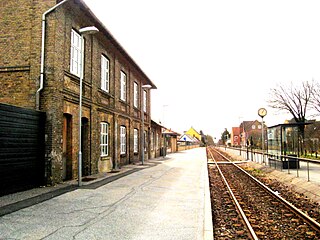
Aars or Års, is a Danish town with a population of 8,657 in Himmerland, Denmark. Administratively, Aars is the municipal seat of Vesthimmerland Municipality and biggest town of Vesthimmerland Municipality, Region Nordjylland since 2007 and it was also the seat of the mayor in the now abolished Aars Municipality. The town was founded in the 14th century. It is one of the four principal towns of Vesthimmerland, the other ones being Farsø, Løgstør and Aalestrup. Aars is a former railway town. It is currently the 76 largest city in Denmark just behind Ribe but in front of Helsinge on Zealand, Sjælland. It is the 11th biggest town/city in Region Nordjylland in front of Skagen but just behind Sæby. The town has the nickname Cimbri's town.

Løgstør is a town in Denmark with a population of 3,972 It is located 47 km west of Aalborg and 64 km north of Viborg. Løgstør's city centre consists of old streets with small houses built in the 1800s for fishermen and sailors. One of these houses was donated by Danish housemen to the author and poet Johan Skjoldborg in 1918, who lived in the house until his death. It is located on Johan Skjoldborgs Vej.

Lindholm Høje is a major Viking burial site and former settlement situated to the north of and overlooking the city of Aalborg in Denmark.

The North Jutlandic Island, Vendsyssel-Thy, or Jutland north of the Limfjord, is the northernmost part of Denmark and of Jutland. It is more common to refer to the three traditional districts of Vendsyssel, Hanherred, and Thy, however. The area has been intermittently a tied island and, during modern times, was not surrounded by water until a storm in February 1825, which severed the region from the remainder of Jutland and caused a water connection between the North Sea and the western end of the Limfjord. Hence, it is traditionally regarded as a part of Jutland rather than a separate island.

A Viking ring fortress, or Trelleborg-type fortress, is a type of circular fort of a special design, built in Scandinavia during the Viking Age. Collectively, they may also be known as trelleborgs. These fortresses have a strictly circular shape, with roads and gates pointing in the four cardinal directions. They are sometimes partially encircled by advanced ramparts, though not always circular.

The Limfjord is a shallow part of the sea, located in Denmark where it has been regarded as a fjord ever since Viking times. However, it now has inlets both from the North Sea and Kattegat, and hence separates the North Jutlandic Island from the rest of the Jutland Peninsula. The Limfjord extends from Thyborøn Channel on the North Sea to Hals on the Kattegat. It is approximately 180 kilometres long and of an irregular shape with numerous bays, narrowings, and islands, most notably Mors, and the smaller ones Fur, Venø, Jegindø, Egholm and Livø. It is deepest at Hvalpsund.

Hanstholm is a small town and a former island, now elevated area in Thisted municipality of Region Nordjylland, located in northern Denmark. The population of the town is 2,088.

Jammerbugt Municipality is a municipality in the North Jutland Region on the North Jutlandic Island. It is located along the coast of Skagerrak to the north and the Limfjord to the south. It borders the municipalities of Thisted, Vesthimmerland, Aalborg, Brønderslev and Hjørring.

Vesthimmerland Municipality or Vesthimmerlands Municipality is a municipality in the North Jutland Region in Denmark. It covers an area of 768,08 km² (2013) and has a total population of 36,431 (2023). The Municipality borders Jammerbugt Municipality to the south and to the east it borders Rebild and Aalborg Municipality and to the south it borders Viborg Municipality and to the south-east it borders Mariagerfjord Municipality.

European route E39 is the designation of a 1,330 kilometres (830 mi) north–south road in Norway and Denmark from Klett, just south of Trondheim, to Aalborg via Bergen, Stavanger and Kristiansand. In total, there are nine ferries, more than any other single road in Europe.

Aggersborg is the largest of Denmark's former Viking ring fortress, and one of the largest archaeological sites in Denmark. It is located near Aggersund on the north side of the Limfjord. It consists of a circular rampart surrounded by a ditch. Four main roads arranged in a cross connects the fortress center with the rampart's outer ring. The roads were tunneled under the outer rampart, leaving the circular structure intact.

Aalborg County is a former province in Denmark, located in north-eastern Jutland around the eastern approach to the Limfjord. Aalborg County was established in 1793 and abolished in 1970 when it merged with Hjørring County forming the new North Jutland County.

Thy is a traditional district in northwestern Jutland, Denmark. It is situated north of the Limfjord, facing the North Sea and Skagerrak, and has a population of around 44,000. The capital is Thisted. Snedsted, Hanstholm and Hurup are minor towns in the area.

Han Herred or Hanherrederne is a traditional district in northern Jutland, Denmark. It lies between Thy in the west and Vendsyssel in the east. To the north it faces the North Sea (Skagerrak) and to the south the Limfjord. There are only two towns with more than 1,000 inhabitants, Fjerritslev and Brovst.

Livø is a 320-hectare Danish island located in the central body of the Limfjord, approximately midway between Nykøbing Mors, Løgstør, Fjerritslev and Thisted. As of 2022, the island has 6-year-round residents.

The Vendsyssel railway line is a 80.7 km (50.1 mi) long standard gauge single track railway line in Denmark which runs through the historical region of Vendsyssel between Aalborg and Frederikshavn in North Jutland. It constitutes the northernmost part of the East Jutland longitudinal railway line, the through route along the east coast of the Jutland Peninsula from the German border at Padborg to Frederikshavn.

Vrå railway station is a railway station serving the railway town of Vrå in Vendsyssel, Denmark.
Peder Vognsen was bishop of the Diocese of Aarhus from 1191 until his death in 1204. He belonged to the nobility as a member of the Hvide clan and was related to Archbishop Absalon. He used his extensive private means to found Aarhus Cathedral. He established several prebends for the cathedral which were authorized by Pope Celestine III in 1197 and confirmed by Pope Innocent III in 1198. From the deed of his donation to the cathedral in 1203, it can be seen he owned a large estate in Zealand including four churches. Peder Vognsen is entombed in Aarhus Cathedral. He is commemorated by a black marble slab in the chancel.
Overlade is a village/town in western Himmerland, Denmark, with a population of 427, located 12 km north from Farsø, 16 km south of Løgstør, 3 kilometers from Limfjord and seven kilometers south of Ranum. The village is located in the North Denmark Region and belongs to the Vesthimmerland Municipality. The village was founded by the monks of Vitskøl Abbey most likely the monks were from the Cistercian Order. The village has in recent history been a rich business with several factories, forges, bakeries, butcher sale, bicycle shop and much more. The village inn burned down in 1984. Like many small towns, some of these businesses through time has gone, but the town still has some shops and craft stores.

A former municipality in Region Nordjylland on the Jutland Peninsula in northern Denmark. The municipality, including the island of Livø, covered an area of 218 km2 (84 sq mi), and had a total population of 10,270 (2005). Its last mayor was Jens Lauritzen, a member of the Venstre political party.
























